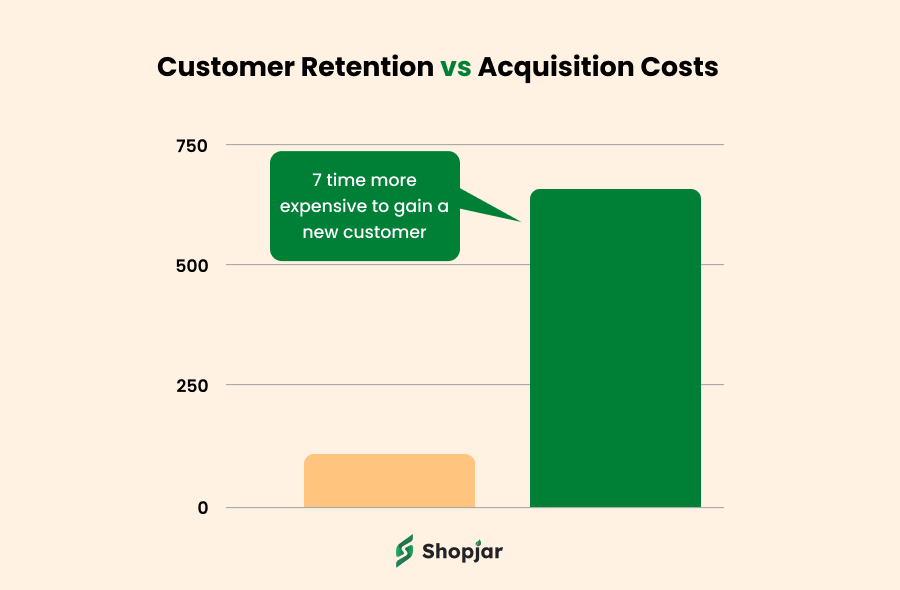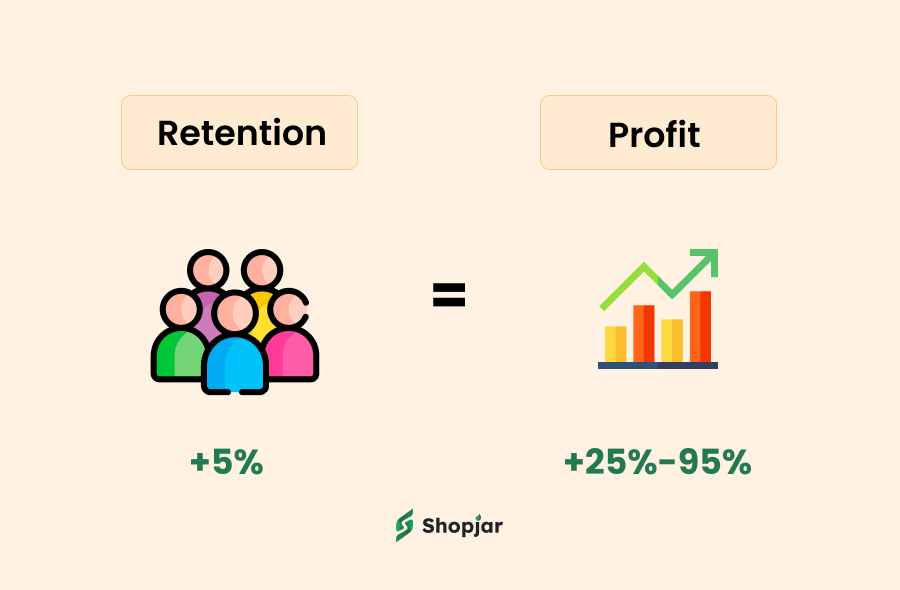In the realm of business, posing the question, “customer acquisition or retention?” Which is better may lead to a misunderstanding. Customer acquisition and customer retention—are fundamental elements of success. These strategies are not rivals but integral counterparts contributing to a holistic and thriving business model.
Customer acquisition is about attracting new customers, while customer retention focuses on keeping the existing ones. Both customer acquisition and retention needed to build strong customer relationships and grow a business effectively.
Whether you’re an experienced business owner, a new entrepreneur, or simply someone interested in understanding business, this guide will help. We’ll explain these concepts in a simple, understandable way and show why balancing both is important for a successful business.
Are you tired of constantly chasing new customers? Let us show you how to retain the ones you have.
What is Customer Retention?
Customer Retention focuses on maintaining and enhancing relationships with existing customers to encourage their continued business. It’s the practice of delivering such a satisfying customer experience that existing customers remain loyal to your business.
For example, in order for agencies or businesses that sell software as a service (SaaS) to generate a substantial recurring monthly income from their customers, they need to have a high customer retention rate. A service like the GoHighLevel SaaS pricing can help them achieve this feat
What is customer acquisition?
Customer Acquisition is the strategy employed to attract and convert new customers to your business. It’s about reaching out to potential customers, showcasing the benefits of your products or services, and persuading them to choose you over your competitors.
The Importance of Customer Acquisition and Retention on Growth
The Importance of Customer Retention
Boosting customer retention rates by just 5% could potentially escalate profits by 25% to 95%. Additionally, data from a customer experience agency indicates that loyal customers are approximately five times more likely to make repeat purchases and equally likely to be forgiving.
Cost Efficiency: Retaining existing customers is generally more cost-effective than acquiring new ones. Various studies suggest that it can cost five times more to attract a new customer than to retain an existing one.
Loyalty and Repurchases: Loyal customers are more likely to make repeat purchases, often buying more over time. This increases the lifetime value of these customers to your business.

Referrals: Satisfied, loyal customers often act as brand advocates, recommending your business to their network. This word-of-mouth marketing is valuable for new customer acquisition. With the aid of referral marketing apps, this process can be efficiently managed and scaled
The Importance of Customer Acquisition
The expense associated with attracting a new customer can be as much as 7 times higher than the cost involved in keeping an existing one.
Business Growth: The most apparent reason customer acquisition is essential is business growth. Without acquiring new customers, your business can’t grow or expand. New customers bring in fresh revenue and can help increase market share.
Sustainability: The business environment is always changing, and customer needs and preferences can shift over time. Regular customer acquisition ensures you stay relevant and competitive in your industry.
Word-of-Mouth Marketing: Newly acquired customers can also help spread the word about your business to others, leading to a potential increase in brand awareness and reputation.
How Customer Acquisition and Retention Drive Growth
While it’s true that customer acquisition and retention focus on different aspects of the customer journey—bringing new customers in and keeping existing ones engaged—both play an equally pivotal role in driving business growth. Despite their unique characteristics, they share substantial common ground in their pursuits, which can be illustrated as follows.
Customer-Centric Approach: Both acquisition and retention strategies revolve around the customer. Be it welcoming new customers using referral programs or nurturing relationships with the existing ones, the ultimate aim of customer acquisition and customer retention is to provide an outstanding customer experience.
This might involve delivering a seamless purchasing process, providing exceptional customer service, or offering personalized communication.
Value Proposition: The success of both acquisition and retention hinges on the value proposition of a business. Attracting new customers and retaining existing ones both necessitate offering a product or service that meets the customers’ needs and provides value.
Branding and Reputation: Both these strategies play a significant role in shaping the business’s brand image and reputation. A positive experience can turn both new and existing customers into brand advocates, leading to referrals and positive reviews that can help attract even more customers.
Strategic Planning and Effort: Both acquisition and retention require a thoughtful strategy and concerted effort. They demand an understanding of customer behavior, effective communication, and strategic engagement initiatives to either attract or retain customers.
Metric Analysis: Both customer acquisition and retention strategies necessitate the tracking and analysis of key metrics to gauge success and inform future strategies. This could include metrics like cost of customer acquisition, customer lifetime value, churn rate, customer satisfaction scores, and more.
Understanding and implementing effective customer acquisition and customer retention strategies form the backbone of any successful business model. Both of these elements play pivotal roles in the business ecosystem, each complementing the other to drive business growth.
How customer retention differs from customer acquisition?
Focus: Customer acquisition is all about attracting new customers. It involves identifying potential customers, reaching out to them, and convincing them to choose your business over others. On the other hand, customer retention is about keeping existing customers and nurturing them to maintain a long-term business relationship. It involves increasing customer satisfaction, loyalty, and engagement.
Methods: Acquisition strategies might include marketing campaigns, promotional offers, and advertising to attract new customers. Retention strategies often involve customer support, loyalty programs, personalized communication, and improving the customer experience to keep existing customers happy.
Costs: Generally, customer acquisition is more expensive than customer retention. It can cost five times as much to attract a new customer than to keep an existing one. This is because acquisition involves marketing and advertising costs, whereas retention leverages an existing relationship.
Goals: The goals of acquisition and retention are also different. Acquisition aims to expand the customer base and increase market share, while retention aims to maximize the lifetime value of customers and foster customer loyalty.
Metrics: Different metrics are used to measure the success of acquisition and retention. Acquisition metrics might include the cost of customer acquisition, conversion rates, and response rates. Retention metrics could include churn rate, customer lifetime value, and customer satisfaction scores.
In the debate of customer retention vs customer acquisition, it’s clear that a balance of both propels a business forward. While customer acquisition brings fresh customers to your business, customer retention ensures these relationships are maximized for their full potential value.
Customer Acquisition Strategies
Referral/Affiliate Marketing:
Implementing referral or affiliate marketing strategies can significantly boost customer acquisition. In referral marketing, you incentivize your current customers to refer others to your business.
Content Marketing:
Create valuable, engaging content that captures attention and helps prospective customers understand your products or services better. This can be blog posts, videos, podcasts, infographics, etc.
Search Engine Optimization (SEO):
Optimize your website and content to rank higher in search engine results, which helps attract more organic traffic.
Social Media Advertising:
Platforms like Facebook, Instagram, LinkedIn offer targeted advertising that can be tailored to a specific audience demographic, thus attracting potential customers.
Influencer Marketing:
Collaborate with influencers in your industry who can showcase your product or service to their followers, creating awareness and trust.
Email Marketing:
When it comes to devising strategies for customer acquisition and retention, email marketing stands out as a powerful and cost-effective tool. It offers a direct line of communication to your customers, allowing you to nurture these relationships over time.
While both customer retention and customer acquisition are important for a business’s success, they have different impacts on your business’s bottom line.
Customer Retention Strategies
Exceptional Customer Service:
Quick and effective customer service can solve issues and turn a potentially negative experience into a positive one, thus increasing customer loyalty.
Referral Rewards:
Retention can also be boosted with referral marketing. By rewarding your existing customers for successfully referring new customers, you not only incentivize the act of referring but also create a positive experience and connection with your existing customers.
Loyalty Programs:
Offer rewards for repeat purchases or referrals. This encourages customers to keep coming back and refer others.

Personalization:
Personalize communications, offers, and products or services based on your customers’ behaviors and preferences. This shows customers you understand and value them.
Regular Engagement:
Keep your brand at the top of customers’ minds by regularly engaging with them through emails, social media, or other touchpoints.
Customer Feedback:
Regularly collect and act on customer feedback. This shows customers that their opinion matters and helps you improve your product or service.
Understanding the ROI of Customer Acquisition and Retention
ROI on Customer Acquisition
To measure the ROI of these activities, businesses need to consider the Cost of Customer Acquisition (CAC). This cost includes all the expenses incurred to acquire a new customer, including marketing costs, advertising costs, labor costs, and any other associated costs.
ROI = [(Revenue from New Customers – CAC) / CAC] * 100%
ROI on Customer Retention:
To measure the ROI on customer retention, businesses commonly use the metric of Customer Lifetime Value (CLTV). The CLTV represents the total net profit that a company makes from any given customer throughout their relationship.
ROI = [(CLTV – Cost of Customer Retention) / Cost of Customer Retention] * 100%
It’s important to highlight that although both customer acquisition and retention are vital for business success, customer retention often yields a higher ROI. Research shows that increasing customer retention rates by even 5% can increase profits by 25% to 95%.
Are you ready to see real growth? Start focusing on customer retention now.
Conclusion
Navigating the business landscape demands carefully balancing between attracting new customers and keeping existing ones engaged. While customer acquisition and retention may seem like two distinct strategies, they are, in fact, two sides of the same coin, each contributing significantly to a business’s success.
Both customer acquisition and retention share several similarities, including the emphasis on delivering exceptional customer experiences, contributing to brand reputation, and requiring strategic planning and efforts. They are interconnected elements that feed into each other to drive business growth.
Customer acquisition attracts new customers, expanding a business’s reach, while customer retention nurtures and maintains relationships with existing customers. Both are crucial for a business’s growth and sustainability.
While customer acquisition strategies often involve external marketing and promotions to attract new customers, retention strategies focus more on enhancing the customer experience, loyalty programs, and regular engagement with existing customers.
Customer acquisition helps expand your customer base and market reach, whereas customer retention maximizes the lifetime value of these customers. Together, they help maintain a steady customer base while also facilitating business growth.
Acquiring a new customer often involves marketing, promotional campaigns, and sometimes even discounts, all of which can be costly. On the other hand, retaining an existing customer primarily involves maintaining a strong relationship, which is typically less expensive.
Referral marketing is a strategy that encourages satisfied customers to recommend a business to their network. It is a powerful form of word-of-mouth marketing that can lead to new customer acquisition, especially when managed and scaled effectively using referral marketing apps.
Affiliate marketing is a performance-based marketing strategy where a business rewards one or more affiliates for each visitor or customer brought by the affiliate’s marketing efforts. This can significantly expand a business’s reach and boost customer acquisition.
